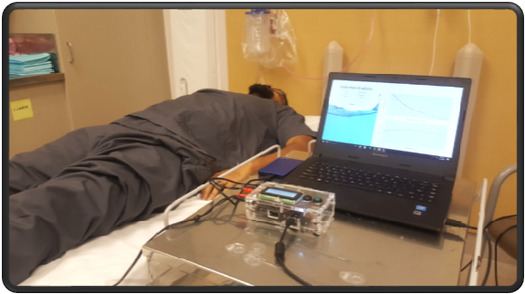Gareth's good thinking about drinking
30 Nov 2016 - 10:52:23 in Research
 An Honours-year Electronics and Computer Systems Engineering student won’t find his good ideas drying up any time soon. That’s because this year, Gareth Clay built a ‘Bioimpedance Hydration Measurement Device’ that could prove handy for emergency department doctors treating dehydrated patients on the go.
Gareth’s device enables doctors to form an accurate picture of the volume of fluid within a person’s body by measuring their ‘body impedance’, or the resistance and reactance of the body.
The hydration level of a patient is extremely important to the treatment options prescribed, especially on admission in an emergency room setting. Low levels of hydration in patients who are already weak due to sickness or injury can lead to complications that compromise patient health.
“I’ve made a unique device using all the skills I’ve learnt from my university studies”, says Gareth. “It could really help doctors in their day to day work. A lot of people are interested in developing it further”.
The project was proposed by Dr Sapi Mukerji, an emergency department doctor working at Lower Hutt hospital, who contacted Victoria about the potential to collaborate on developing some biomedical products he had been thinking about.
Several clinical techniques already exist to measure the hydration levels of a patient. However, Gareth’s new technique has been praised for being less invasive and less expensive than current commercial bioimpedance devices. His device was also found to be precise to within 1%.
“It’s always nice to have a real world application for a project – it’s really motivating!” says Gareth. “It was easy to see how this device would be helpful to doctors and that made the project all the more appealing and interesting to be part of”.
Gareth has already landed his dream job at Fisher and Paykel Healthcare, which he says was “definitely” helped by the fact that he had developed a medical device at university.
“It was a lot of fun and a great learning experience because it’s the first chance you get as an Engineering student to develop a large project independently”, he says. “It was also a time to refine all my learning, solidify the theory and practise the practical stuff I needed to hit the ground running when I entered the workforce”.
Gareth’s advice to other Honours students is to get as much done as early as possible.
“I put a lot of work into the first trimester, when the workload was easier, and it really paid off”, he says. “It meant I had time for setbacks and to refine my ideas, including actual testing with patients in the final stages of the project.
“The next step in the process is to decide the feasibility of further development - I would love to see a new commercial product on the market as the result of this idea.”
An Honours-year Electronics and Computer Systems Engineering student won’t find his good ideas drying up any time soon. That’s because this year, Gareth Clay built a ‘Bioimpedance Hydration Measurement Device’ that could prove handy for emergency department doctors treating dehydrated patients on the go.
Gareth’s device enables doctors to form an accurate picture of the volume of fluid within a person’s body by measuring their ‘body impedance’, or the resistance and reactance of the body.
The hydration level of a patient is extremely important to the treatment options prescribed, especially on admission in an emergency room setting. Low levels of hydration in patients who are already weak due to sickness or injury can lead to complications that compromise patient health.
“I’ve made a unique device using all the skills I’ve learnt from my university studies”, says Gareth. “It could really help doctors in their day to day work. A lot of people are interested in developing it further”.
The project was proposed by Dr Sapi Mukerji, an emergency department doctor working at Lower Hutt hospital, who contacted Victoria about the potential to collaborate on developing some biomedical products he had been thinking about.
Several clinical techniques already exist to measure the hydration levels of a patient. However, Gareth’s new technique has been praised for being less invasive and less expensive than current commercial bioimpedance devices. His device was also found to be precise to within 1%.
“It’s always nice to have a real world application for a project – it’s really motivating!” says Gareth. “It was easy to see how this device would be helpful to doctors and that made the project all the more appealing and interesting to be part of”.
Gareth has already landed his dream job at Fisher and Paykel Healthcare, which he says was “definitely” helped by the fact that he had developed a medical device at university.
“It was a lot of fun and a great learning experience because it’s the first chance you get as an Engineering student to develop a large project independently”, he says. “It was also a time to refine all my learning, solidify the theory and practise the practical stuff I needed to hit the ground running when I entered the workforce”.
Gareth’s advice to other Honours students is to get as much done as early as possible.
“I put a lot of work into the first trimester, when the workload was easier, and it really paid off”, he says. “It meant I had time for setbacks and to refine my ideas, including actual testing with patients in the final stages of the project.
“The next step in the process is to decide the feasibility of further development - I would love to see a new commercial product on the market as the result of this idea.”
